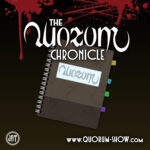This article, part of a series entitled The Quorum Chronicle, appears in expanded audio form exclusively for our Patreon backers. See our Patreon page for further details.
 Real estate speculation has long been a vital part of the American economy — and prompted more than a bit of illicit activity. To quote Gene Hackman as Lex Luthor (to whom we even give a little shout-out in our tale), “Son, stocks may rise and fall, utilities and transportation systems may collapse. People are no damn good. But they will always need land, and they will pay through the nose to get it.” And while Luthor’s plan — destroying half of California to create a new west coast — was appropriately grandiose, befitting an iconic movie supervillain, we’re definitely more grounded in Quorum.
Real estate speculation has long been a vital part of the American economy — and prompted more than a bit of illicit activity. To quote Gene Hackman as Lex Luthor (to whom we even give a little shout-out in our tale), “Son, stocks may rise and fall, utilities and transportation systems may collapse. People are no damn good. But they will always need land, and they will pay through the nose to get it.” And while Luthor’s plan — destroying half of California to create a new west coast — was appropriately grandiose, befitting an iconic movie supervillain, we’re definitely more grounded in Quorum.
The contentious Kelo v. City of New London Supreme Court case in 2004 affirmed that city governments had the right to seize property and turn it over to private developers, rather than solely for public works projects.
In my first outlines of the script, the specifics were vaguely defined. I was more interested in developing the character conflicts and general motivations than in the details — at least initially. But once I began researching the backdrop of Los Angeles in 2012 (since, just as “Outstanding Debts” was linked to a specific time, so too would our second story arc, “All That Glitters”), I uncovered a wealth of real-life drama that I could incorporate as backdrop, even if substantially modified to work within the scope of our tale.
The most memorable of these, of course, is the demolition and replacement of the Sixth Street Viaduct, which spans the LA river from the city’s downtown Arts District to Boyle Heights. Originally built in 1932, the bridge had long been an iconic fixture of the Los Angeles cityscape, being featured in countless films and television series, including Grease, Terminator 2, Gone in 60 Seconds, Tapeheads, 24, and Lost, just to name a few. It was even declared eligible for inclusion in the National Registry of Historic Places. But engineers discovered that the substandard chemical composition of the bridge’s concrete had resulted in a chemical process known as alkali-silica reaction (colloquially referred to as “concrete cancer”), causing it to deteriorate a mere 20 years following its construction. Various methods had been used over the decades to try and ameliorate the damage, but ultimately, seismic vulnerability studies revealed that the bridge was in danger of collapse in the event of a major earthquake, and the bridge’s inevitable closure and demolition planning began. A design competition was launched for the bridge’s replacement in April of 2012, with the winning submission — from architect Michael Maltzan and the Kansas City-based HNTB infrastructure design firm — being announced that October. The new design, called “The Ribbon of Light,” features sweeping cable-supported arches, and will accommodate not only the original bridge’s four traffic lanes, but also dedicated bicycle lanes and 14-foot-wide sidewalks, as well as multiple sets of stairs allowing pedestrians to descend from the bridge to the planned 12-acre Sixth Street Parc below. This new community space is expected to include basketball courts, soccer fields, fitness areas, a dog park, skate park, amphitheater, and several picnic and garden areas. In other words, a much larger development than simply replacing the existing structure with something comparable. Once I learned more about the project, I knew that — with a little creative embellishment — it would serve as a particularly apt anchor for one of the critical revelations in “All That Glitters.” Closure and demolition began in January of 2016, and after several delays, the bridge is finally scheduled to reopen in the summer of 2022.
Be sure to check out the complete article, in both text and enhanced audio formats, along with the rest of The Quorum Chronicle series, at our Patreon page. And thanks so much for your continuing support of Jabberwocky Audio Theater!
— William R. Coughlan, writer/director of Quorum
